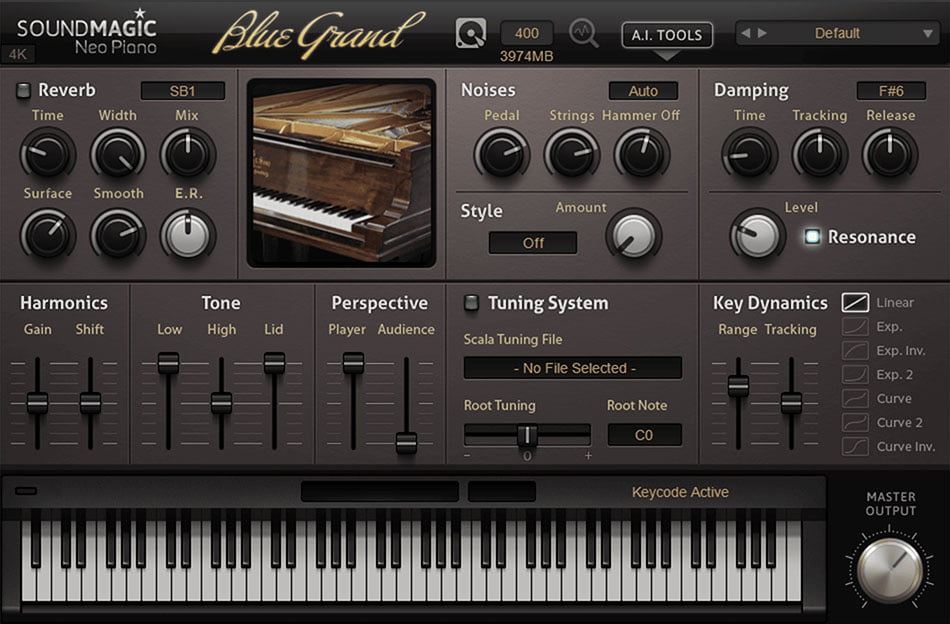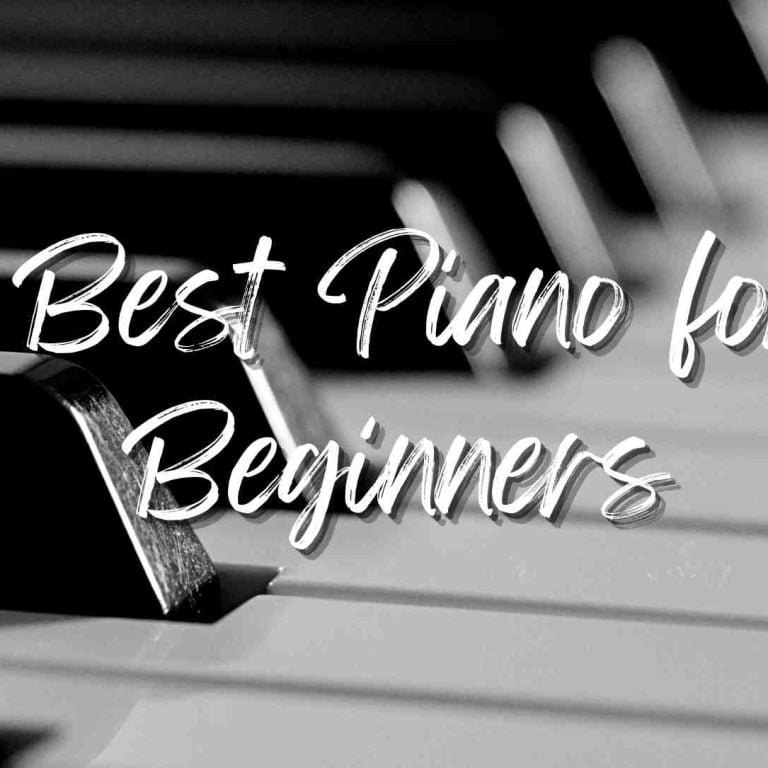The notes on a piano are the fundamental building blocks of music, creating melodies and harmonies. We will explore the importance of understanding and mastering these notes, from the basic layout of the keyboard to the relationship between keys and their corresponding sounds.
Starting with an overview of the piano’s structure, we will then delve into the arrangement of the white and black keys and how they are named. Furthermore, we will discuss the concept of octaves, which form the basis of musical scales and chords.
By the end, you will have a solid understanding of the notes on a piano and be ready to explore the vast world of music.

Credit: www.kvraudio.com
Understanding The Anatomy Of A Piano
Introduction
When it comes to learning and appreciating the beauty of music, the piano is an instrument that never fails to captivate. As you sit in front of this magnificent musical wonder, have you ever wondered about its intricate anatomy, the very structure that brings enchanting melodies to life? In this blog post, we will explore the various components that make up a piano, unraveling the secrets behind the harmonious symphony it produces. Let’s begin by understanding the keyboard, the musical canvas upon which melodies are painted.
The Keyboard: A Musical Canvas
The Keyboard: A Musical Canvas
The keyboard of a piano is often compared to a musical canvas, where the artist, in this case, the musician, creates melodic masterpieces. Comprised of an arrangement of white and black keys, this quintessential feature allows the pianist to effortlessly navigate through different musical scales and tonalities. Each key represents a specific note, and by skillfully combining them, musicians can express their emotions and convey messages through music.
Exploring the Octaves: Low and High Notes
Exploring The Octaves: Low And High Notes
Octaves play a crucial role in the piano’s range of notes. An octave refers to the span from one note to another of the same name, but at a different pitch. The piano spans a wide range of octaves, providing musicians with the ability to explore both low and high notes. The lower octaves produce deep and rich tones, while the higher octaves offer a sense of brilliance and clarity. This range allows for the creation of breathtaking compositions that showcase the versatility of the instrument.
The Black and White Dichotomy: Sharps and Flats
The Black And White Dichotomy: Sharps And Flats
The black and white keys on a piano not only create a visually striking contrast but also serve a musical purpose. The white keys represent the natural notes, such as C, D, E, and so on, while the black keys provide the sharps and flats, adding complexity and variety to the music. Sharps raise a note by a half-step, while flats lower it by a half-step. This dichotomy of black and white adds depth and color to compositions, giving pianists endless possibilities for creative expression.
Conclusion
In conclusion, understanding the anatomy of a piano allows us to appreciate the thought and craftsmanship behind its creation. The keyboard serves as a musical canvas, giving life to melodies through an arrangement of white and black keys. Exploring the octaves grants musicians the ability to play both low and high notes, expanding the sonic possibilities of the instrument. The black and white dichotomy of sharps and flats provides a sense of contrast and richness in musical expression. By delving into the intricacies of a piano’s anatomy, we gain a deeper appreciation for the artistry embedded within this beautiful instrument.
Unleashing The Power Of Musical Scales
Music has the extraordinary ability to evoke emotions, captivate our minds, and transport us to another world. Behind this magic lies a fundamental element of music: scales. Scales provide the backbone of melody and harmony, unleashing endless possibilities for musical expression. In this blog post, we will explore the power of different musical scales and how they contribute to the richness and versatility of piano music.
The Building Blocks Of Melody: Major And Minor Scales
When it comes to creating melodies, Major and Minor scales are the essential building blocks. The Major scale, consisting of seven notes and a distinct pattern of whole steps and half steps, is often associated with bright and joyous compositions. It creates a sense of uplifting and positive energy, making it a popular choice for many musical genres. On the other hand, the Minor scale, with its melancholic and introspective character, adds depth and emotional intensity to compositions. It is often used in sad or contemplative pieces to convey a sense of longing or sorrow.
The Versatility Of Chromatic Scales
In addition to Major and Minor scales, the Chromatic scale expands the horizons of musical expression. Unlike other scales, the Chromatic scale includes all twelve notes within the octave, creating a continuous sequence of half steps. This versatility makes the Chromatic scale an excellent tool for adding tension, dissonance, or unexpected twists and turns to compositions. By incorporating chromatic passages or using chromatic chords, composers can spice up their music and take listeners on a thrilling sonic journey.
Exploring Unique Sounds: Pentatonic And Blues Scales
When it comes to creating unique sounds, the Pentatonic and Blues scales are go-to choices for many musicians. The Pentatonic scale, as the name suggests, consists of five notes per octave, omitting the fourth and seventh scale degrees. This simplicity gives the Pentatonic scale a universal appeal and makes it accessible to musicians of all skill levels. Used in various musical traditions around the world, this scale brings a sense of timelessness and offers countless possibilities for improvisation.
Originating from African-American musical traditions, the Blues scale adds a distinctive flavor to compositions. It combines the Minor Pentatonic scale with the addition of a “blue note,” a flattened fifth. This added note infuses compositions with a soulful, melancholic, and expressive quality often associated with the blues genre. Whether incorporated in blues, jazz, or rock music, the Blues scale enables musicians to create captivating and emotionally charged performances.
By understanding and harnessing the power of musical scales, pianists can unlock endless creative potential. Major and Minor scales lay the foundation, providing melodies with bright or introspective qualities. The Chromatic scale expands the possibilities, adding tension and excitement to compositions. Finally, the Pentatonic and Blues scales offer unique sounds that captivate listeners. Now, it’s time for you to explore these scales on your piano, and let your musical journey unfold!
Mastering Piano Techniques: From Beginner To Pro
Mastering Piano Techniques: From Beginner to Pro is a comprehensive guide that helps you understand the notes on a piano. Whether you’re a novice or aiming to become a pro, this resource provides valuable insights and techniques to enhance your piano playing skills.
Getting A Strong Start: Proper Hand And Finger Placement
When it comes to learning the piano, having a solid foundation is essential. One of the first things you should focus on is proper hand and finger placement. This fundamental technique will not only improve your playing efficiency but also help prevent any potential injuries down the line.
To achieve optimal hand placement, your fingers should be slightly curved and relaxed, hovering just above the keys. Your wrist should be level with the keys, ensuring there is no unnecessary tension. This position allows for quick and controlled movements.
Proper finger placement is crucial for accurate playing. Begin by placing your thumb on middle C (the white key closest to the center of the piano) and then assign each finger to the subsequent white keys. Your fingertips should strike the keys with a gentle yet firm touch, producing a clear and resonant sound.
Learning To Read Sheet Music: Notes, Rhythms, And Symbols
To truly master the piano, it is essential to be able to read sheet music. This universal language allows musicians to communicate ideas and express emotions through their playing. By understanding the notes, rhythms, and symbols on the sheet music, you gain insight into the composer’s intended musical expression.
Notes are represented by different symbols that indicate their pitch and duration. Each note occupies a specific place on the musical staff, which consists of five horizontal lines and four spaces. Familiarizing yourself with the different note names and their corresponding positions on the staff is crucial for fluent reading.
The rhythm of a piece is the arrangement and duration of the notes and rests. It is represented by various symbols, such as whole notes, half notes, quarter notes, and eighth notes. Understanding these rhythmic values and their relationships to one another is instrumental in maintaining a steady tempo and playing with precision.
Sheet music also contains a variety of symbols that provide instructions on dynamics, articulation, and phrasing. Dynamics indicate the volume at which to play, such as pianissimo (very soft) or fortissimo (very loud). Articulation symbols guide you on how to play a note, such as staccato (short and detached) or legato (smooth and connected).
Developing Expressive Playing: Dynamics And Articulation Techniques
To elevate your piano playing from a technical level to a truly expressive artform, understanding dynamics and articulation techniques is vital. These elements bring life and emotion to your performance, allowing you to convey the composer’s intentions and your own interpretation.
By mastering dynamics, you gain the ability to create contrast and highlight specific musical phrases. Experiment with playing softly during delicate passages and gradually increasing the volume during more intense sections. Dynamic markings, such as crescendo (getting louder) and diminuendo (getting softer), provide guidance for these nuanced variations.
Articulation techniques affect the duration, attack, and release of each note. For instance, staccato notes are short and detached, while legato notes are smooth and connected. By utilizing techniques such as accents and slurs, you can emphasize certain notes or create seamless transitions between them.
Unlocking The Magic Of Chords And Chord Progressions
Unlock the magic of chords and chord progressions on a piano to create captivating melodies. Discover the power behind each note and explore the endless possibilities of musical composition. Experience the transformative beauty of playing chords and watch as your music comes to life.
Chords and chord progressions are the building blocks of music, the secret ingredients that give a song its emotional depth and power. Whether you are a musician, a songwriter, or a music lover, understanding the magic behind chords and chord progressions can enhance your appreciation and enjoyment of music. In this blog post, we will explore the world of chords on a piano, from the fundamental triads to the intricate chord progressions that define different genres. So let’s dive in and unlock the magic!
Triads: Building Blocks Of Harmony
Triads are the foundation of harmony in music. They consist of three notes played simultaneously, each note a third apart from the previous one. Triads are named after their root note, which is typically the lowest note played. The three types of triads commonly used are major, minor, and diminished. Major triads have a bright and uplifting sound, while minor triads create a more melancholic and introspective atmosphere. Diminished triads, on the other hand, have a dissonant and unresolved quality. Let’s take a look at these triads in more detail:
| Triad Type | Notes | Symbol |
|---|---|---|
| Major | Root, Major Third, Perfect Fifth | △ |
| Minor | Root, Minor Third, Perfect Fifth | – |
| Diminished | Root, Minor Third, Diminished Fifth | ° |
The Theory Behind Chords: Major, Minor, Augmented, And Diminished
Chords go beyond the simplicity of triads, venturing into richer and more complex harmonic territories. In addition to major, minor, and diminished chords, there are also augmented chords that add a unique sense of tension and brightness to a composition.
Here’s a breakdown of these chord types: – Major chords are built using the root, major third, and perfect fifth intervals, creating a sense of stability and resolution. – Minor chords substitute the major third with a minor third, resulting in a more introspective and somber mood. – Augmented chords raise the fifth interval by a half step, intensifying the tension within the chord. – Diminished chords, similar to diminished triads, have a dissonant and unresolved sound due to the use of a minor third and diminished fifth.
Progressing With Purpose: Common Chord Progressions In Different Genres
Chord progressions are the backbone of a song, guiding its harmonic flow and adding an extra layer of emotion and structure. Different genres often have distinct chord progressions that contribute to their unique musical identity. Let’s take a look at some common chord progressions in various genres: PopBluesRockJazzClassical – Prolonged and intricate progressions that explore the vast possibilities of harmonic expression, ranging from simple to complex. Understanding these common chord progressions can help you analyze and appreciate music from various genres.
Whether you’re a pianist, guitarist, or songwriter, experimenting with these progressions can inspire your own musical creations and take your playing to new heights. Now that we have unlocked the magic of chords and chord progressions, you have the knowledge to delve into the world of music with a deeper understanding and appreciation. Armed with this understanding, you can embark on a musical journey, exploring the limitless possibilities that chords and their progressions offer. So go ahead, play the notes on a piano and let the magic unfold!
Expressing Emotion Through Piano Playing
Expressing emotion through piano playing is a powerful way to communicate feelings. The notes on a piano serve as the language, allowing musicians to convey their innermost emotions with depth and clarity.
Exploring Different Playing Styles: Classical, Jazz, Pop, And More
Utilizing Techniques For Expressive Playing: Vibrato, Trills, And Glissando
Playing the piano is not just about hitting the right notes; it’s about conveying emotions and telling a story through music. The piano offers a wide range of techniques that allow pianists to express themselves in unique and captivating ways. By incorporating techniques such as vibrato, trills, and glissando, players can add depth and emotion to their performances. Vibrato is a technique commonly used in classical music, where the pianist slightly and rapidly alternates between two adjacent notes. This creates a beautiful wavering effect, adding warmth and expression to the sound produced.
It is often used to evoke feelings of longing, passion, or sadness, further enhancing the emotional impact of a piece. Trills, on the other hand, involve rapid alternating between a main note and its upper or lower adjacent note. This technique adds a touch of excitement and flamboyance to piano playing. It can be employed in various genres, including classical, jazz, and even pop, allowing musicians to infuse their performances with a sense of playfulness and virtuosity. Another technique that opens up a world of expressive possibilities is glissando.
Playing a glissando involves sliding or “gliding” the fingers across the keys, producing a smooth and continuous sound. Glissandos can range from short and subtle slides to long and dramatic sweeps, depending on the desired effect. This technique is often associated with jazz and blues music, where it adds a touch of improvisation and spontaneity to the performance.
Adding Personal Touch: Improvisation And Interpretation
While sheet music provides a blueprint for playing a piece, true expression comes from the pianist’s personal touch. Improvisation and interpretation allow musicians to make a piece their own, infusing it with their unique style and emotions. Improvisation involves spontaneously creating melodies, harmonies, and rhythms on the spot. It is a skill commonly associated with jazz and allows pianists to explore their creativity and showcase their musical intuition. Through improvisation, a piece can be transformed into something entirely unique, capturing the essence of the performer and captivating listeners.
Interpretation, on the other hand, involves the pianist’s understanding and expression of the composer’s intentions. It requires careful study of the score, historical context, and the emotional landscape represented in the music. By adding their own personal interpretation, pianists can breathe new life into a familiar piece, emphasizing certain nuances or emotions that resonate with them. As pianists delve into the world of expressing emotions through piano playing, they discover a vast range of techniques and playing styles.
Exploring different genres such as classical, jazz, and pop expands their repertoire and allows for a greater understanding of musical expression. By utilizing techniques like vibrato, trills, and glissando, pianists can add depth and emotion to their performances. Finally, by adding their personal touch through improvisation and interpretation, they create a truly memorable and captivating musical experience.
Frequently Asked Questions Of The Notes On A Piano
What Are The Notes On A Piano?
The notes on a piano are the individual sounds produced when the keys are pressed. Each key represents a specific note, ranging from A to G. The notes repeat in a pattern across the keyboard, with higher and lower octaves available for playing.
What Are The 5 Basic Piano Notes?
The five basic piano notes are A, B, C, D, and E. These notes form the foundation of playing the piano and are essential for learning music.
How Do You Memorize Piano Notes?
Memorizing piano notes is achieved through consistent practice, repetition, and visualizing the keys. Familiarize yourself with the note names on the keyboard, use flashcards or mnemonic devices, and play scales and exercises regularly. Practice reading sheet music to further reinforce the notes’ positions on the staff.
What Are The Main Parts Of A Piano?
The main parts of a piano include the keyboard, strings, soundboard, hammers, pedals, and the wooden case. Each part plays a crucial role in producing the beautiful sound that we associate with a piano.
So, keep practicing, experimenting, and exploring the beautiful melodies that can be created with the keys of a piano. Start your musical journey today!
For read our more blogs, Click Here




